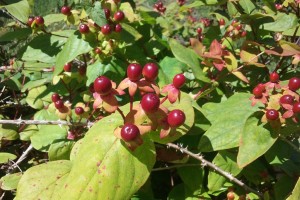Tutsan beetle
History in New Zealand
Tutsan beetles are native to Georgia in Europe. They were first imported by Manaaki Whenua - Landcare Research for study in 2014. Permission to release the beetles was granted by the EPA in 2016. The tutsan beetle has not been used as a biocontrol agent anywhere in the world before. The first releases of the beetle were made in 2017. The beetle has since been released widely in the North Island at a limited number of sites. Establishment has been confirmed at one or two sites in the North and South Islands.
How would I find/recognise it and what is its lifecycle?
The best time to find tutsan beetles is spring through to mid-summer. Look for leaves with notched edges and for whole leaves that have been eaten away. The adults are an iridescent purple colour and are around 10-15 mm in size. There are no obvious size differences between males and females.

Image: tutsan beetle (Chrysolina abchasica).
The damage may be easier to see than the adult beetles themselves which spend much of their time hiding in the soil and leaf litter during the day.
Females produce more than 100 offspring over a 3-4 month period from spring to mid-summer. Small yellow cigar-shaped eggs may occasionally be seen but will often be infertile. Fertile eggs usually hatch within a few hours of being laid and young larvae are more commonly seen than eggs.
Image: tutsan beetle egg.
The creamy to pale green coloured larvae become fat and squat as they grow reaching 6-8mm long. Larvae are often found on the underside of the leaves. Pre-pupal larvae are bright green, almost fluorescent in colour.
Image: young tutsan beetle larva.
Image: tutsan beetle larvae close to pupation.
Pupation occurs in the ground and takes around 2-3 weeks. New adults emerge from early to mid-summer and feed on the foliage. The beetles then spend the winter hiding away in the soil, emerging in spring to mate and produce offspring. The adults live for about a year, and there is only one generation produced per year.
Image: tutsan beetles mating.
You are unlikely to confuse the tutsan beetle with other insects. It is similar looking to the St John's wort beetles (Chrysolina spp.) but, since tutsan is a poor host for these beetles, they are unlikely to be found on tutsan unless there is a lot of St John's wort (Hypericum perforatum) nearby. A moth has also been released as a biocontrol agent for tutsan, but its creamy-coloured caterpillars primarily attack the fruits.
See St John's wort beetles and Tutsan moth.
How does it damage tutsan?
The adults beetles and larvae feed on tutsan leaves sometimes stripping plants of all their foliage.
Image: tutsan beetle chewing damage.
Will it attack other plants?
Testing of the beetles showed that they could attack and develop on native Hypericum species under laboratory conditions. However, a comparison of their performance on these species compared to tutsan, and the outcome of similar experiences with other agents, suggests that these results are just a laboratory artefact, and that any attack in the field on them is extremely unlikely. Tutsan beetles may attack St John’s wort in the field but this weed is a less preferred host for them than tutsan. No other plants are expected to be at risk.
How effective is it?
We do not know what impact the tutsan beetles will have in New Zealand. However, the closely related St John's wort beetles are extremely damaging on a closely related host (Hypericum perforatum) so we expect the tutsan beetle could be a highly effective agent in due course.
Image: tutsan beetle feeding damage.
How can I get the most out of it?
If the tutsan beetle establishes at initial release sites it would be worth helping to establish them in all areas where they are needed. The adults can fly but are likely to disperse fairly slowly, possibly only a few kilometres per year.
How do I select a release site?
Read Guidelines for selecting release sites for biocontrol agents.
How do I collect it for release at other sites?
Once the beetle is present in good numbers collect and shift at least 300-500 larvae and/or several hundred adults to each new site during summer. To collect them try beating the plants for adults and cutting foliage with larvae on it.
How do I manage the release sites?
Avoid any activities that will interfere with the beetles, such as herbicide application. If you need to undertake control measures, then avoid the release site.

